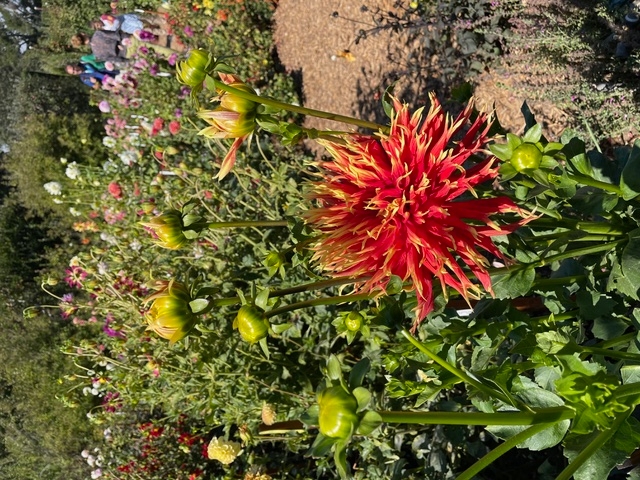I've been eager to satisfy my appetite for English gardens since visiting the Cotswolds region earlier this year. Fortunately, one doesn't need to travel to the U.K. to experience such a place. We have a great example in Northern California.
It has been more years than I can remember since my first visit to Filoli, the former Bourn-Roth estate in Woodside. So in some ways it felt like being there for the first time.
William Bourn was the prosperous owner of a gold mine who, with his wife Agnes, built Filoli as a self-sufficient country estate. Designed by Willis Polk, the famous San Francisco architect, the mansion took three years to build and was completed in 1917. Twenty years later, after both of the Bourns were deceased, William and Lurline Matson Roth purchased the property. Lurline Roth was the heir to the Mattson shipping fortune and the one who donated the entire 650-acre estate, in 1975, to the National Trust for Historic Preservation. Today it is open for public tours and nature hikes and draws 400,000 visitors a year.
Entering through the original carved oak door that the former owners brought from their home in San Francisco, I encountered the beautiful garden “rooms” area. Indeed, there are many gatesand paths interspersed in the 16 acres of formal gardens. They add to the whimsy and appeal of Filoli.
Visiting in early September, I found roses, dahlias and begonias in abundance and full bloom. Unfortunately, the hydrangeas were past their prime, but they were gigantic. According to Flowers magazine, Filoli is home to one million daffodils, which must put on quite a show in spring. Being a rose fan, I was thrilled to see so many still in bloom, among them ‘Lady of Megginch,' ‘Lady of Shalott' and ‘Secret.'
Adjacent to the Rose Garden and after the Knot Garden is a marvelous collection of dahlias (my second favorite flower). They were so beautifully colored and striking. Among the standouts: ‘Heather Marie,' ‘Clyde's Choice,' ‘Pearson's Colleen,' ‘Show ‘N' Tell' (perhaps my favorite) and ‘Crichton Honey.'
Further down, in the so-called Panel Garden, there were large beds of a knee-high plant with lovely coral-colored blooms. A label identified the plant as ‘Gaza' but I'm still unsure what it was.
Just beyond this garden, I took the pathway steps leading up to the High Place. From this vantage point, you can look back to the yew allée and enjoy the view. Walking back down the yew allée, I was surprised by the expansive pool pavilion area. Adding to the charm of the walk were small pots of Echeveria ‘Purple Pearl' and small ceramic and stone ornamental sculptures.
Of course, at the end of the self-tour, we had to go into the garden gift shop. Needless to say, I spent some money and time there and walked out with some souvenirs.
After lunch on the dining room terrace, we visited the historic house. While the “bones” of the rooms have not been altered, the furniture and decorations changed with ownership. Admittedly, I must have either not paid enough attention on my first visit or just focused on certain rooms more than others. I did not recall much from that visit, although I distinctly remember the layout of the Gentlemen's Lounge, particularly the pool table.
This time, the Library made an impression, with all the shelves of books that belonged to the Bourns. The Drawing Room was notable as well. It included the only known photo of Agnes Bourn entertaining and pouring tea. After dinner, the women would withdraw to this room, while the men remained in the dining room. Times have changed, of course. Perhaps that's why we don't see drawing rooms in homes nowadays.
Of course, to serve all these folks, they had an expansive butler's pantry and kitchen. These rooms had serving ware on display and all the original appliances, including the original stoves.
Unfortunately, the Ballroom was being restored and no entry was allowed. The rooms upstairs were also not open to the public. Still, I would recommend spending part of your day visiting this historic house.
There is so much more to see and do at this huge estate. I would highly recommend spending a full two days there if you want to take in the expansive California Trail or Spring Creek Trail.
Fall Faire: Join the UC Master Gardeners of Napa County for an entertaining and educational event on Saturday, September 28, from 1 pm to 4 pm, outdoors at University of California Cooperative Extension, 1710 Soscol Avenue, Napa. Enjoy exhibits on composting, monarch butterflies, succulents, water conservation, bees and more. The program includes activities for kids, a scarecrow contest, giveaways and music. Admission is free.
Library Talk: Join UC Master Gardeners of Napa County and Napa Public Library for a free talk on “Thirsty Lawn to Low-Water Succulents and Perennials: A Step-by-Step Guide” on Thursday, October 3, from 7 pm to 8 pm, via Zoom. Don't let analysis paralysis stop you from achieving your new climate-appropriate garden. Join the UC Master Gardeners of Napa County on a step-by-step journey from weedy, labor-intensive lawn to a garden of succulents and perennials with year-round color. Register here.
Workshop: Join UC Master Gardeners of Napa County for a workshop on “Soils, Compost and Mulch” on Wednesday, October 9, from 6:30 pm to 8:30 pm, at the Pelusi Building, 2296 Streblow Drive in Napa. Pat Costello, the City's water resources analyst, will summarize the eight principles of water-wise landscaping. Master Gardeners will examine local soil types and demonstrate how to improve your soil with aeration, amendments and mulch.
Help Desk: The Master Gardener Help Desk is available to answer your garden questions on Mondays and Fridays from 10 am until 1 pm at the University of California Cooperative Extension Office, 1710 Soscol Avenue, Suite 4, Napa. Or send your questions to mastergardeners@countyofnapa.org. Include your name, address, phone number and a brief description.
Attached Images:
